A sensitive landscape and stiff local opposition presented the team building Britain’s longest railway bridge with a major challenge. Thomas Lane reports on how they got on
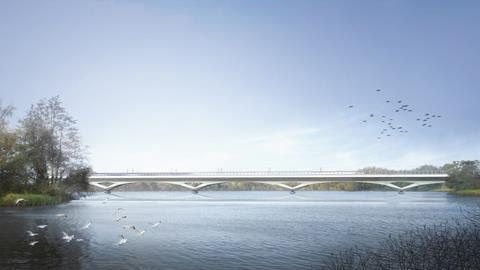
The team building the section of HS2 that runs over the Colne Valley and through the Chiltern Hills are used to opposition. HS2 has been a controversial project from the start and this section is one of those at the top of the list.
This team, called Align, is a joint venture between Bouygues, Sir Robert McAlpine and VolkerFitzpatrick. They are building C1, a relatively short, 21.6km-long section beginning near Ruislip in the south and finishing near Great Missenden to the north-west. This section, which is costing £1.6bn, takes in one of the most complex and arguably sensitive parts of HS2.
The line crosses the Colne Valley, an area of lakes and woodland on a 3.4km-long viaduct before diving underground underneath the Chiltern hills for 16km. Located on the edge of west London, the Colne Valley is a popular destination for walking, fishing, cycling, watersports and horse riding. Parts of the site are a designated site of special scientific interest (SSSI) and include ancient woodland.
>> Also read: Should the scope of HS2 be cut to save money?
The Chilterns is an area of outstanding natural beauty (AONB), so unsurprisingly, there was fierce opposition to HS2 when it was first proposed. Yet HS2 and Align have negotiated their way through the consent maze and brought everyone on board.
“We went from some of the most vociferous opposition on HS2 to Schedule 17 approval [consent to proceed] with absolutely no conditions,” explains Alan Price, the technical director for the Align JV. “Nobody else [on other sections of HS2] has got planning consent without any conditions.”
How did HS2 and Align engineer such a dramatic volte-face and build what has become the poster child of HS2, the Colne Valley viaduct?
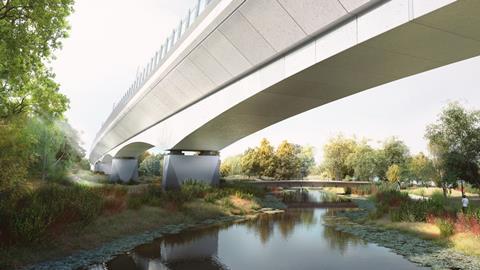
Designing the viaduct
Design quality was key to winning over opponents. These included Hillingdon and Buckinghamshire councils, the Woodland Trust, Herts & Middlesex Wildlife Trust, the Colne Valley Regional Park and local residents.
HS2 established a design vision in 2015 with three key principles: designing for the benefit of people, places and for legacy. An independent design panel chaired by Sadie Morgan, founding director of dRMM, was established at the same time to advise and hold to account the HS2 leadership on matters of design.
As part of this process Knight Architects was commissioned to develop a so-called specimen design for the viaduct with input from a panel made up of many of the objectors, including the local councils, the wildlife trusts and Colne Valley Regional Park.
The braking load from a train travelling at 300kmph is over 9,000 tonnes so you have to transfer a huge amount of load into the deck
Alan Price, Align JV
The specimen design shows an elegant, low structure with long, swooping arches supported by V shaped piers skimming over the lakes. The design varies according to the terrain so woodland areas feature shorter arches and vertical piers.
The piers are facetted with rough cast areas to soften their bulk and taper gently towards the sculpted deck which cantilevers elegantly from the piers.
Align, which won the contract in July 2017 shortly after the specimen design was finished, had to turn aspiration into reality. This included taking account of geotechnical conditions where the piers are located and the technical requirements for a high-speed line.
“A lot of what we had to do was finding the most efficient way of providing the structure,” Price explains. “With a high-speed railway, all the load comes from the trains. The braking load from a train travelling at 300kmph is over 9,000 tonnes so you have to transfer a huge amount of load into the deck. What is the most efficient way of getting the load from the deck through the piers to the ground?”
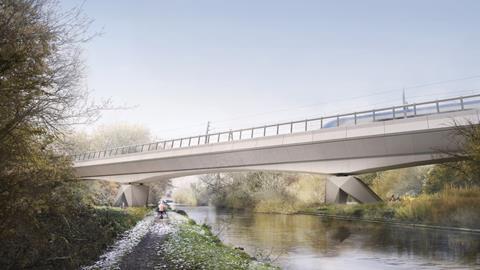
Price adds that there were doubts over the buildability of the specimen design because some of the elements were so slender. And the technical requirements and realities of the site also necessitated changes to the spans, the piers and the deck. But local stakeholders had been sold a concept and wouldn’t take kindly to it being watered down.
“It was good that the specimen design raised design expectation but it was also a challenge to move away from something stakeholders took literally as you don’t know all the technical requirements or the site survey information and the design is so driven by the technical requirements,” explains Chris Patience, principal at architect Grimshaw.
Detailed ground investigations were carried out and a test pile built and tested to destruction to inform and verify the substructure design. “This allowed us to optimize the piles,” Price says. “Based on the original design principles, these were about 60m long. We got these down to 40m which is a 27% saving. That was a good start.”
The viaduct is very low, with a height of around 10m. This mininises the visual impact of the viaduct as it runs through rather than over trees in the wooded areas and sits low on the water. Keeping the viaduct so low was a challenge so the spans over water were reduced from 105m to 80m so a shallower deck could be used. The arches over woodland areas are shorter at 40-60m to increase headroom near the arches where there are a lot of people.
The deck was slimmed in width by 1.5m by squeezing the services together as much as possible and the cross-section simplified to reduce weight and make it easier to build. “The really important thing about minimising the weight of the deck is the impact on the structure generally,” Patience says.
“The heavier the deck, the bigger the piers and foundations. The whole structure becomes huge.” The noise barrier design above the parapet was also refined to make this as discreet as possible.
We were really pushing hard to get the design done because the best way of derisking construction is to have a completely signed off design
Alan Price, Align JV
3D models of sections of the specimen and revised design were made. “We took these to the stakeholder meetings so they could hold them in their hands and compare the weight,” Price says, adding there was 60% more concrete in the specimen design.
The end result respects the specimen design yet is cheaper and easier to build with less embodied carbon, something that impressed HS2 design director Kay Hughes. “Align have done this really well, refining, improving, making everything much leaner and more beautiful,” she says.
Developing the design to production stage and gaining local support removed what Price says was a massive risk to Align. “We were really pushing hard to get the design done because the best way of derisking construction is to have a completely signed off design”. When consent to proceed was granted in April 2020 the team was ready to go.
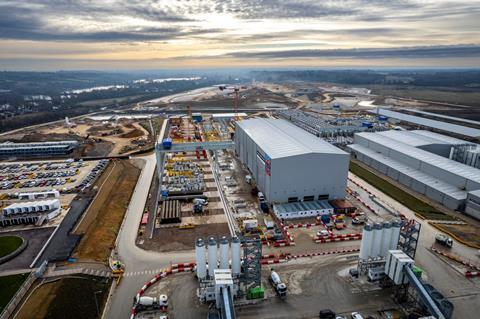
Building the viaduct
Align JV’s vast site is sandwiched between the M25 and the north end of the Colne Valley. The reason for the site’s size is because as much as possible is being manufactured here rather than trying to do this at the construction coalface. There is a factory to make the segments for the viaduct structural deck and a second factory to produce 112,000 segments for the Chilterns tunnel lining.
“We have tried to do as much as possible on the site so we have three batching plants to mix all the concrete here so it doesn’t go on the roads. The viaduct and tunnel segment precast factories are here, and all the spoil from the tunnels is treated here and used for the landscaping,” Price says.
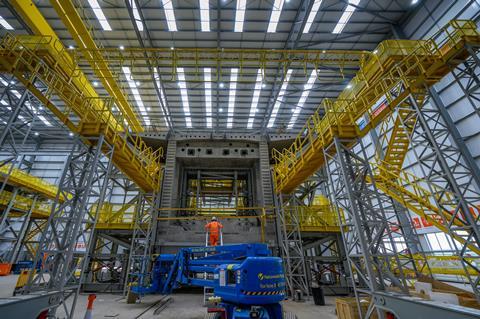
The viaduct factory will churn out 1,000 segments for the 3.4km-long deck. Each segment is unique as these vary in depth depending where along the arch it is located with the viaduct built on a curve which varies in radius along its length.
The first job is to assemble the rebar cages for each segment which arrives in precut lengths. The cages are put together as sub assemblies in jigs to simplify and speed up the process then the subassemblies are joined together.
The rebar cages go into a 100m long shed housing three casting stations. These are adjustable to accommodate the different angles and depths of each segment.
The segments are match cast; a plastic sheet is placed between the last segment to be cast and the one being worked on. This ensures the segments fit together perfectly. The concrete is poured in the evening and the mould struck the following morning with the factory producing an average of two segments a day.
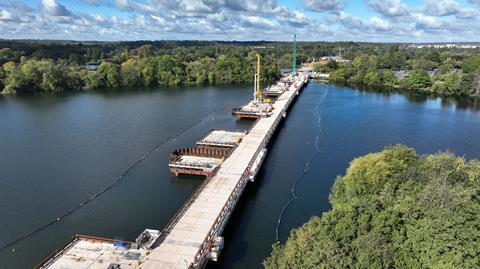
An access road has been built along the full length of the viaduct including across the lakes. The first job is to build caissons in the water followed by piles and pile cap. The piling for the viaduct is now finished. The next job is to cast the piers ready for deck construction.
Balanced cantilever construction is used for the deck. Segments are progressively added to each side of each pier to keep the loads on the pier in balance. Once the span centre is reached work starts on the next section so the deck halves meet. The segments on the other half of this pier are then ready to meet the segments reaching back from the pier next in line.
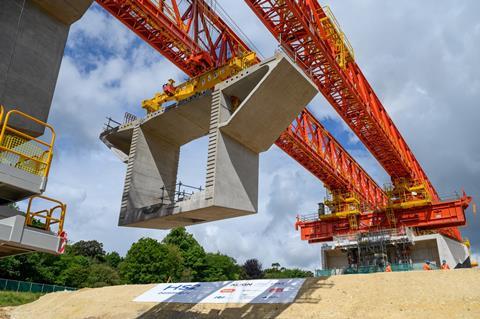
VAlign has used the extensive bridge building experience of Bouygues for the construction of the Colne Valley viaduct. Bouygues has built several bridges in Hong Kong using a launch girder and has brought the system to the UK for the first time. First used to build the East Tsing Yi viaduct in 2004, the girder, which has been nicknamed Dominque, has been brought to the UK in sections and assembled to form a 160m long, 18m wide box section weighing 700 tonnes. Ideal for long bridges with a high degree of repetition, a launch girder streamlines the construction process making it faster, safer and with less environmental impact.
The launch girder sits on two supports over the deck to be constructed. Work started on the deck in May last year. Individual segments are brought from the factory and a winch on the girder lifts these from the delivery vehicle. An epoxy resin is applied to the segment surface and the winch orientates it into the right direction and positions it against the previous segment. The girder has two main winches allowing the segments to be built simultaneously out from each pier in both directions to keep the load balanced.
Temporary steel strands are fed through holes in the segments and tensioned to hold the segments together. Permanent strands will be used to post-tension each span, this ultimately gives the viaduct its carrying capacity.
The launch girder can slide along the supports to the next pier, the supports are relocated as the pier advances. By mid-March some 700m of deck should be completed.
The viaduct is supported on 56 piers which vary according to location and function. V-shaped piers are used for the long spans over the water with simple vertical piers used for shorter sections over woodland. All these piers feature sliding bearings located near the base to allow the viaduct deck to move according to the temperature. Movement is controlled with two special types of pier located at 900m intervals.
Three pairs of fixed buttresses anchor the viaduct at approximately 900m intervals and will be located in key places including over the Grand Union Canal. These alternate with three pairs of expansion piers. These are two piers located side by side – the deck features a 600mm gap above these piers to enable it to expand.
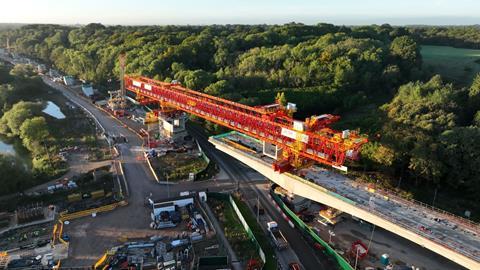
The goal is to complete the viaduct by 2025. With the deck in place, the next job will be to install the parapet on either side; this will be made from ultra-high strength concrete to keep the weight on the deck down.
The parapet has a facetted, folded geometry to add visual interest and echo the design of the other viaduct elements. Four different types of noise barrier will be installed depending on the proximity of adjacent properties.
Four metres high, a solid, noise absorbent material is fixed to the internal sides of the parapet with a variety of different treatments above this including transparent and solid areas. Other work includes fitting the robust concrete kerbs on either side of the track to contain a train in the event of a derailment, overhead power lines and the track.
The Colne Valley will offer HS2 passengers their first rural views after leaving London when trains start running in six to 10 years’ time. Taking just 40 seconds to cross the viaduct, few will have any idea of all the effort, care and money that has gone into designing and building it. Appreciating this will be the preserve of those organisations and individuals who were initially opposed.
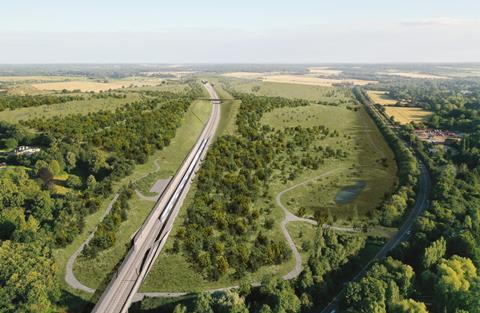
The landscaping
Landscape impacts have been one of the most sensitive flashpoints for HS2 objectors, particularly for the C1 section as the railway passes over the Colne Valley and through the Chiltern hills AONB. To mitigate the concerns of locals and environmental groups, considerable effort has gone into ensuring HS2 leaves a positive legacy behind. This is particularly challenging in the case of the Chiltern tunnel as building it will produce three million cubic metres of chalk spoil which is being retained on the site.
Leigh Crowhurst, landscape architect for the Align JV, explains the integrated project team approach that was adopted for the landscape design. “Sometimes landscaping is seen as an add on at the end and we are there to green up the edges,” he says. “Here we were very much part of the design team from the start. What we wanted to pull together was a vision for the whole of C1.”

That vision includes creating 127 hectares of new chalk grassland, woodland and wetlands. The largest element of the scheme is where the HS2 construction site is located, an area known as the Colne Valley western slopes near the Chiltern tunnel. This area will include 88 hectares of calcareous grassland, adding 10% to the region.
The spoil from the tunnel is being processed – it is piped out as a slurry from the tunnelling and is partially dried out – before being spread out and landscaped.
The joined-up approach to design meant that a 650m long culvert, needed to drain the land on the far side of the M25 down into the Colne Valley, was reduced in length to just 28m. This was achieved by re-engineering the landscaping to incorporate drainage ditches.

Crowhurst describes the chalk spoil as having the consistency of playdough. It is spread out in 0.5m layers and compacted before the next layer is added.
Cranfield university worked with soil science and landscape engineering specialist Tim O’Hare Associates to trial the soil profiles needed for the calcareous grassland. This must be free draining, alkaline and low in nutrients.
Aggregate will be laid over the reclaimed chalk and a 200mm layer of topsoil placed over it. This will be planted with grass and flower species and native trees and shrubs.
The team has thought about how this will be managed in the long term and settled on native cattle breeds. “Believe it or not, but cattle grids were one of the most difficult things to get consented with some of the highway authorities,” says Crowhurst.
“Hertfordshire hasn’t got any cattle grids so we went on a very long journey explaining how it worked, how it is sustainable and how it benefits not just the highways and the community and the habitat.”
In the viaduct area the main priority has been preserving the ancient woodlands and SSSI. Another 3 hectares of water bodies will be created and 4.5 of cycling, walking and horse riding routes which include the road built for the viaduct construction. The earthworks will be shaped in two areas to create viewing points so people can admire the viaduct.
“If you think about these things from the start it is not that expensive to do,” Price says. “If you try and add them in afterwards it can involve big changes and can get expensive. If you are shaping the landscape anyway, then creating a flat bit doesn’t cost much.”
The benefits of an integrated project team

Unusually for a contracting joint venture, Align includes a design team that comprises Jacobs and French engineer Ingerop. Called Align D, this team is fully integrated into the joint venture to enable designers and contractors to develop designs collaboratively.
The idea is that the team produces design solutions that use materials as efficiently as possible and are easily buildable. This saves carbon and money without compromising the designer’s original vision.
The idea for this approach came from the experience of some of the team on the Nimes to Montpelier high-speed line in France. “We have never done it in the UK before,” says Price. “We have taken it and adapted it for here, the whole concept of the contractor being part of the design JV and the design JV being completely open and transparent within the JV itself.”
Everybody was in the room and felt they were equal. If you don’t get those behaviours from the start, you end up with a very adversarial relationship between the designer and the contractor
Alan Price, Align JV
Creating an integrated project team requires creating the right environment for people to collaborate freely. The first step was to create a set of corporate values that embed the idea people are working for Align rather than one of the constituent partners.
“We are creating a new entity, a new company so we needed to guide people and give them some rules,” explains Daniel Altier, project director for Align. “The key is communication where we explain to people what our vision is and how we work. You need to explain that we work together and make decisions together.”
Altier says the team had to work hard to get people to leave their individual corporate identities behind them. “You need to build the trust in the teams which doesn’t happen in a week,” he says. “In time people were thinking they were Align, not Bouygues, SRM or VP.”
Price adds that this upfront work is the key to success. “It comes down to people, leadership and behaviours as this drives the model,” he says. “If you have the right people – we have a brilliant team – then we were able to merge what comes from the architects, the structural designers, the methods team for the best solution. Everybody was in the room and felt they were equal. If you don’t get those behaviours from the start, you end up with a very adversarial relationship between the designer and the contractor.”
>>See more: Building the Future Commission
The integrated project team approach enabled faster decision making which gave HS2 the confidence that Align could deliver such a complex and unique structure on time and budget. “It [the approach] was so successful that we got to the point at the first stage where we had a design that was agreed and buildable as opposed to something that you have designed but didn’t know how you were going to build,” Price says.
Part of the Align culture was challenging everything on the table to see if the team could come up with a better solution. For example, the Chiltern tunnel has five ventilation shafts which are located in the AONB which required a sensitive approach to the design of the headhouses.
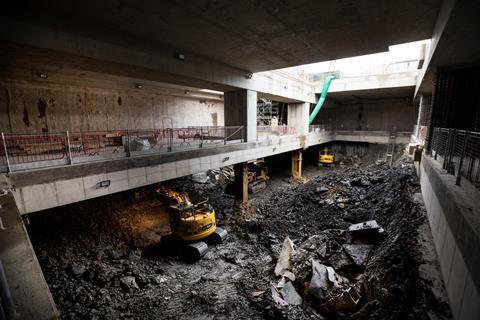
The height of these was reduced by 2m by putting ventilation plant underground to the side of the headhouses rather than at the top of the shafts. The headhouses have been designed to look like local agricultural buildings to help these blend into the landscape.
The principle of challenging every assumption also extended to the specifications handed down by HS2. Price explains that HS2 issued new standards saying all manhole covers had to have 351 attributes within the BIM model, which would be expensive to implement. Price says most of these were unnecessary and questioned it with HS2.
Eventually he got the green light to justify why this number of attributes were unnecessary. “HS2 asked me to write a proposal and we got 351 attributes down to about 70,” he explains.
“In the end HS2 agreed it was a sensible proposal and instructed all the other contractors to do the same. We could have just sat back and said if you want 351 attributes for a manhole cover we will do it and you can pay the bill. But we didn’t.”
Hughes describes the integrated project team approach as the “holy grail” for design and build procurement and praises the approach adopted by Align. She says: “They have been very clear about what their purpose is. They have used visual language in all their communications to show people that purpose and what they are intending to achieve. And it is not just values, but the overall estate they are going to leave behind. I think that creates a huge amount of purpose for everybody which the values underpin.”
Project team for Colne Valley viaduct
Client HS2
Specimen design Knight Architects
Architect Grimshaw
Engineer Align D (Jacobs & Ingerop)
Contractor Align JV (Bouygues, Sir Robert McAlpine & VolkerFitzpatrick



























1 Readers' comment